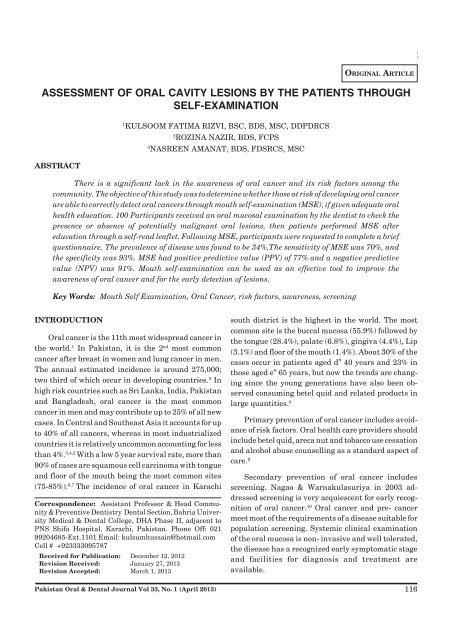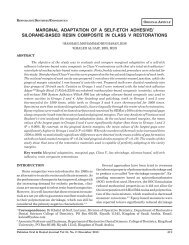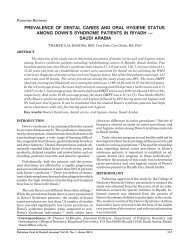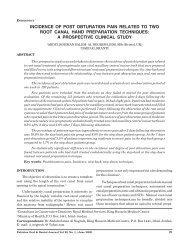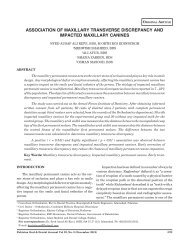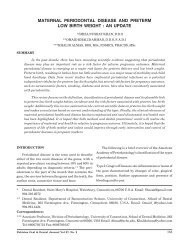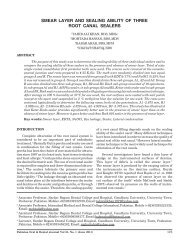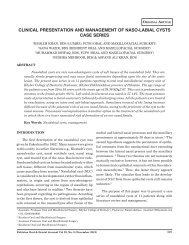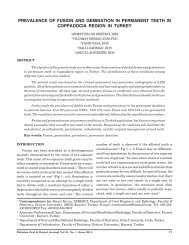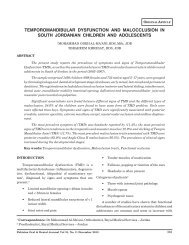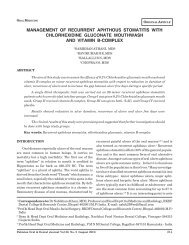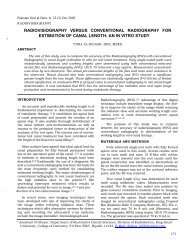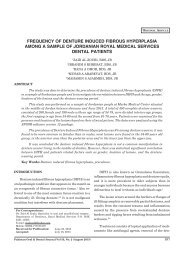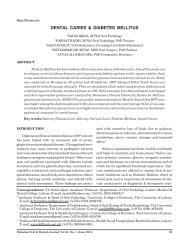assessment of oral cavity lesions by the patients through self ...
assessment of oral cavity lesions by the patients through self ...
assessment of oral cavity lesions by the patients through self ...
Create successful ePaper yourself
Turn your PDF publications into a flip-book with our unique Google optimized e-Paper software.
Oral <strong>cavity</strong> <strong>lesions</strong> <strong>through</strong> <strong>self</strong>-examination<br />
ORIGINAL ARTICLE<br />
ASSESSMENT OF ORAL CAVITY LESIONS BY THE PATIENTS THROUGH<br />
SELF-EXAMINATION<br />
1<br />
KULSOOM FATIMA RIZVI, BSC, BDS, MSC, DDPDRCS<br />
2<br />
ROZINA NAZIR, BDS, FCPS<br />
3<br />
NASREEN AMANAT, BDS, FDSRCS, MSC<br />
ABSTRACT<br />
There is a significant lack in <strong>the</strong> awareness <strong>of</strong> <strong>oral</strong> cancer and its risk factors among <strong>the</strong><br />
community. The objective <strong>of</strong> this study was to determine whe<strong>the</strong>r those at risk <strong>of</strong> developing <strong>oral</strong> cancer<br />
are able to correctly detect <strong>oral</strong> cancers <strong>through</strong> mouth <strong>self</strong>-examination (MSE), if given adequate <strong>oral</strong><br />
health education. 100 Participants received an <strong>oral</strong> mucosal examination <strong>by</strong> <strong>the</strong> dentist to check <strong>the</strong><br />
presence or absence <strong>of</strong> potentially malignant <strong>oral</strong> <strong>lesions</strong>, <strong>the</strong>n <strong>patients</strong> performed MSE after<br />
education <strong>through</strong> a <strong>self</strong>-read leaflet. Following MSE, participants were requested to complete a brief<br />
questionnaire. The prevalence <strong>of</strong> disease was found to be 34%.The sensitivity <strong>of</strong> MSE was 70%, and<br />
<strong>the</strong> specificity was 93%. MSE had positive predictive value (PPV) <strong>of</strong> 77% and a negative predictive<br />
value (NPV) was 91%. Mouth <strong>self</strong>-examination can be used as an effective tool to improve <strong>the</strong><br />
awareness <strong>of</strong> <strong>oral</strong> cancer and for <strong>the</strong> early detection <strong>of</strong> <strong>lesions</strong>.<br />
Key Words: Mouth Self Examination, Oral Cancer, risk factors, awareness, screening<br />
INTRODUCTION<br />
Oral cancer is <strong>the</strong> 11th most widespread cancer in<br />
<strong>the</strong> world. 1 In Pakistan, it is <strong>the</strong> 2 nd most common<br />
cancer after breast in women and lung cancer in men.<br />
The annual estimated incidence is around 275,000;<br />
two third <strong>of</strong> which occur in developing countries. 2 In<br />
high risk countries such as Sri Lanka, India, Pakistan<br />
and Bangladesh, <strong>oral</strong> cancer is <strong>the</strong> most common<br />
cancer in men and may contribute up to 25% <strong>of</strong> all new<br />
cases. In Central and Sou<strong>the</strong>ast Asia it accounts for up<br />
to 40% <strong>of</strong> all cancers, whereas in most industrialized<br />
countries it is relatively uncommon accounting for less<br />
than 4%. 3,4,5 With a low 5 year survival rate, more than<br />
90% <strong>of</strong> cases are squamous cell carcinoma with tongue<br />
and floor <strong>of</strong> <strong>the</strong> mouth being <strong>the</strong> most common sites<br />
(75-85%). 6,7 The incidence <strong>of</strong> <strong>oral</strong> cancer in Karachi<br />
Correspondence: Assistant Pr<strong>of</strong>essor & Head Community<br />
& Preventive Dentistry Dental Section, Bahria University<br />
Medical & Dental College, DHA Phase II, adjacent to<br />
PNS Shifa Hospital, Karachi, Pakistan. Phone Off: 021<br />
99204685-Ext.1101 Email: kulsumhussain@hotmail.com<br />
Cell # +923333095787<br />
Received for Publication: December 12, 2012<br />
Revision Received: January 27, 2013<br />
Revision Accepted: March 1, 2013<br />
Pakistan Oral & Dental Journal Vol 33, No. 1 (April 2013)<br />
south district is <strong>the</strong> highest in <strong>the</strong> world. The most<br />
common site is <strong>the</strong> buccal mucosa (55.9%) followed <strong>by</strong><br />
<strong>the</strong> tongue (28.4%), palate (6.8%), gingiva (4.4%), Lip<br />
(3.1%) and floor <strong>of</strong> <strong>the</strong> mouth (1.4%). About 30% <strong>of</strong> <strong>the</strong><br />
cases occur in <strong>patients</strong> aged d” 40 years and 23% in<br />
those aged e” 65 years, but now <strong>the</strong> trends are changing<br />
since <strong>the</strong> young generations have also been observed<br />
consuming betel quid and related products in<br />
large quantities. 8<br />
Primary prevention <strong>of</strong> <strong>oral</strong> cancer includes avoidance<br />
<strong>of</strong> risk factors. Oral health care providers should<br />
include betel quid, areca nut and tobacco use cessation<br />
and alcohol abuse counselling as a standard aspect <strong>of</strong><br />
care. 9<br />
Secondary prevention <strong>of</strong> <strong>oral</strong> cancer includes<br />
screening. Nagao & Warnakulasuriya in 2003 addressed<br />
screening is very acquiescent for early recognition<br />
<strong>of</strong> <strong>oral</strong> cancer. 10 Oral cancer and pre- cancer<br />
meet most <strong>of</strong> <strong>the</strong> requirements <strong>of</strong> a disease suitable for<br />
population screening. Systemic clinical examination<br />
<strong>of</strong> <strong>the</strong> <strong>oral</strong> mucosa is non- invasive and well tolerated,<br />
<strong>the</strong> disease has a recognized early symptomatic stage<br />
and facilities for diagnosis and treatment are<br />
available.<br />
116
Oral <strong>cavity</strong> <strong>lesions</strong> <strong>through</strong> <strong>self</strong>-examination<br />
The present study is to determine whe<strong>the</strong>r those at<br />
risk <strong>of</strong> developing <strong>oral</strong> cancer are able to correctly<br />
detect potentially malignant <strong>oral</strong> symptoms via mouth<br />
<strong>self</strong>-examination (MSE); <strong>by</strong> health education and<br />
awareness, which will facilitate in prevention <strong>of</strong> disease<br />
and detection <strong>of</strong> disease at an early stage.<br />
METHODOLOGY<br />
This is a cross-sectional study and <strong>the</strong> proposed<br />
research is primarily a study <strong>of</strong> inter- rater agreement<br />
between <strong>the</strong> participant and dentist in recognizing<br />
potentially malignant <strong>oral</strong> symptoms. The research<br />
was conducted in a teaching institute with <strong>the</strong> dental<br />
section catering multi cultural, multi ethnicity, multi<br />
linguistic persons; belonging to different socioeconomic<br />
classes. The study was approved <strong>by</strong> <strong>the</strong> Ethical Committee<br />
and Epi Info was used for sample size calculation.<br />
Recruitment <strong>of</strong> approximately 100 participants<br />
was sufficient to identify 26 participants with changes<br />
in mouth. Purposive, convenient, non-probable sampling<br />
technique was used.<br />
According to Inclusion Criteria, people <strong>of</strong> all age<br />
groups who were exposed to risk factors like; eating<br />
betel quid/areca nut, smokers, and alcohol abusers<br />
were included. People who were already aware <strong>of</strong> <strong>the</strong><br />
premalignant <strong>lesions</strong> in <strong>the</strong>ir mouth were excluded<br />
from <strong>the</strong> study.<br />
A room with adequate light and ventilation was<br />
chosen at <strong>the</strong> premises. A mirror was mounted on <strong>the</strong><br />
wall <strong>by</strong> <strong>the</strong> window to recreate an environment similar<br />
to <strong>patients</strong> own setting for MSE (e.g. home) ra<strong>the</strong>r<br />
than clinical dental room. At <strong>the</strong>ir visit, each participant<br />
was asked to fill consent form after obtaining<br />
enough information on <strong>the</strong> research <strong>through</strong> participation<br />
information sheet. Once consent was obtained,<br />
<strong>oral</strong> visual mucosal examination was conducted <strong>by</strong> <strong>the</strong><br />
dentist. For infection control masks and gloves were<br />
used <strong>by</strong> dentist. Findings were recorded on <strong>the</strong> examination<br />
form. After <strong>the</strong> dentist’s examination, participants<br />
were given a leaflet titled ‘How to spot mouth<br />
cancer early’. Leaflet provides brief outline <strong>of</strong> what is<br />
mouth cancer, early signs <strong>of</strong> mouth cancer, significance<br />
<strong>of</strong> checking mouth and steps <strong>of</strong> Mouth Self<br />
Examination. Participants were asked to read <strong>the</strong><br />
leaflet cautiously and follow <strong>the</strong> instructions to check<br />
<strong>the</strong>ir own mouth. Following MSE, participants were<br />
TABLE 1: SOCIODEMOGRAPHIC DETAILS &<br />
HEALTH RELATED BEHAVIOURS OF<br />
PARTICIPANTS<br />
Sociodemographic Details Frequency<br />
Gender Male 44%<br />
Female 56%<br />
Marital Status Single 45%<br />
Married 51%<br />
Divorced 2%<br />
Widowed 2%<br />
Ethnicity Sindhi 37%<br />
Punjabi 13%<br />
Balochi 5%<br />
Pathaan 11%<br />
Mahajir 34%<br />
Education Graduation 48%<br />
Intermediate 13%<br />
Secondary 21%<br />
Primary 5%<br />
None 13%<br />
Employment Employed 46%<br />
Unemployed 52%<br />
Retired 2%<br />
Health Related Behaviour Frequency<br />
Dental At least every 6%<br />
attendance 6 months<br />
Every 6-12 17%<br />
months<br />
Every 2-5 years 10%<br />
Emergency only 45%<br />
Never 22%<br />
Cigarette Yes 26%<br />
smoking No, but use to 12%<br />
smoke<br />
Never smoked 62%<br />
Eating betel quid 0-5 84%<br />
6-10 4%<br />
11-15 5%<br />
16-20 3%<br />
>20 4%<br />
Eating areca nut 0-5 pkt 83%<br />
6-10 7%<br />
11-15 2%<br />
16-20 5%<br />
>20 3%<br />
Frequency <strong>of</strong> Once a day 30%<br />
checking mouth<br />
Once a week 24%<br />
Once a month 12%<br />
Once a year 4%<br />
Not at all 30%<br />
Pakistan Oral & Dental Journal Vol 33, No. 1 (April 2013)<br />
117
Oral <strong>cavity</strong> <strong>lesions</strong> <strong>through</strong> <strong>self</strong>-examination<br />
requested to complete a brief questionnaire. A questionnaire<br />
to record presence and site <strong>of</strong> potentially<br />
malignant <strong>oral</strong> symptoms, perceived difficulty <strong>of</strong> MSE,<br />
confidence to perform MSE and emotional reaction to<br />
MSE was adopted from <strong>the</strong> study conducted in UK on<br />
MSE and revised for current study. 11 Socio-demographic<br />
details and health-related behaviours were<br />
also recorded via same questionnaire. Participants<br />
were facilitated <strong>the</strong> researcher for <strong>the</strong> completion <strong>of</strong><br />
questionnaire. Both Urdu and English version <strong>of</strong> <strong>the</strong><br />
questionnaire was available. Each participant was<br />
debriefed after <strong>the</strong>y have completed <strong>the</strong> questionnaire.<br />
SPSS version 16.0 was used for statistical analysis<br />
<strong>of</strong> data. Descriptive statistics was used to report perceived<br />
difficulty <strong>of</strong> MSE, confidence to perform MSE,<br />
emotional reaction to MSE, socio-demographic details<br />
and health-related behaviours. Sensitivity, specificity,<br />
positive predictive values (PPV), negative predictive<br />
values (NPV) along with confidence intervals (CI)<br />
were determined to calculate accuracy <strong>of</strong> MSE. Prevalence<br />
<strong>of</strong> <strong>oral</strong> mucosal <strong>lesions</strong> was also calculated.<br />
RESULTS<br />
Out <strong>of</strong> 136 walk-in participants, 104(76.5%) participants<br />
consented to take part in <strong>the</strong> study. Amongst<br />
<strong>the</strong>se 104 participants, 100 participants finally consented.<br />
Out <strong>of</strong> 100 participants <strong>the</strong>re were 44% males<br />
and 56% females, with a mean age <strong>of</strong> 33.5 years,<br />
(standard deviation= SD 14.5) with an age range <strong>of</strong> 19<br />
years to 78 years <strong>of</strong> age. The socio demographic details<br />
and health related behaviours <strong>of</strong> <strong>the</strong> sample are<br />
summarised in Table 1. Oral Examination was performed<br />
<strong>by</strong> dentist and <strong>by</strong> <strong>the</strong> participants; results are<br />
summarised in Table 2 & 3. Amongst <strong>the</strong> 100 participants,<br />
58(58%) found MSE very easy or easy while rest<br />
<strong>of</strong> <strong>the</strong>m found it average or difficult (39%). 8(8%)<br />
participants found MSE very difficult. 70(70%) par-<br />
TABLE 2: FINDINGS OF ORAL EXAMINATION BY THE DENTIST<br />
Lesions Size Site Differential Diagnosis Frequency<br />
Ulcers Present
Oral <strong>cavity</strong> <strong>lesions</strong> <strong>through</strong> <strong>self</strong>-examination<br />
TABLE 4: EMOTIONAL RESPONSES TO MSE<br />
Emotional Responses Frequency<br />
Anxious Not at all 30%<br />
A little bit 34%<br />
Moderately 24%<br />
Quite a bit 10%<br />
Very much 2%<br />
Distressed Not at all 43%<br />
A little bit 27%<br />
Moderately 19%<br />
Quite a bit 8%<br />
Very much 3%<br />
Scared Not at all 55%<br />
A little bit 26%<br />
Moderately 12%<br />
Quite a bit 6%<br />
Very much 1%<br />
Afraid Not at all 56%<br />
A little bit 23%<br />
Moderately 13%<br />
Quite a bit 7%<br />
Very much 1%<br />
TABLE 5: COMPARISON OF FINDINGS OF<br />
MOUTH SELF EXAMINATION AND DENTIST<br />
EXAMINATION<br />
Mouth Self<br />
Examination<br />
Dentist Examination<br />
Present Absent Total<br />
Present 27 11 41<br />
Absent 7 52 59<br />
Total 34 66 100<br />
ticipants were slightly confident, moderately confident<br />
or confident in <strong>the</strong>ir ability to perform MSE,<br />
24(24%) were very confident and only 6(6%) were not<br />
at all confident. Out <strong>of</strong> 100 participants, 82% had<br />
average, clear or completely clear idea <strong>of</strong> how to perform<br />
MSE, 12(12%) had some idea and only 6(6%) had<br />
no idea at all. Participants’ perception <strong>of</strong> MSE is shown<br />
in Table 4.<br />
A simple measure <strong>of</strong> diagnostic accuracy indicated<br />
that <strong>the</strong> proportion <strong>of</strong> correct diagnosis was 79%. The<br />
sensitivity <strong>of</strong> <strong>the</strong> MSE = 70% (95% CI 51% to 88%), and<br />
<strong>the</strong> specificity <strong>of</strong> MSE = 93% (95% CI 87% to 98%).<br />
These measures help in giving more indication <strong>of</strong><br />
presence and absence <strong>of</strong> disease.PPV <strong>of</strong> <strong>the</strong> <strong>oral</strong> <strong>lesions</strong><br />
was found to be 77% (95% CI 59% to 94%) NPV was<br />
Pakistan Oral & Dental Journal Vol 33, No. 1 (April 2013)<br />
91%. (95% CI 84% to 97%). The prevalence <strong>of</strong> disease<br />
was found 34%. MSE was compared with dentist<br />
examination and <strong>the</strong> results are summarised in<br />
Table 5.<br />
DISCUSSION<br />
The opportunities for <strong>oral</strong> cancer control, with<br />
respect to known aetiology, long natural history, possibility<br />
<strong>of</strong> identifying precancerous, <strong>oral</strong> cancer <strong>lesions</strong><br />
<strong>by</strong> <strong>oral</strong> examination and considerable <strong>the</strong>rapy when<br />
diagnosed at early stage directs it towards <strong>the</strong> prevention<br />
<strong>of</strong> <strong>the</strong> disease. 12 Thus, it is important to determine<br />
successful methods <strong>of</strong> encouraging early presentation.<br />
MSE is an adjunct to early detection, and in no way<br />
lessens <strong>the</strong> importance <strong>of</strong> periodic pr<strong>of</strong>essional examination.<br />
To <strong>the</strong> best <strong>of</strong> our knowledge, this is <strong>the</strong> only study<br />
done so far on MSE in Pakistan and <strong>the</strong> second study<br />
(worldwide) to assess accuracy <strong>of</strong> MSE. 11 This strategy<br />
may be used in early detection <strong>of</strong> <strong>oral</strong> cancer, 13 and is<br />
thought to be economically feasible which requires no<br />
scheduling to attend a dentist. It is simple, non-invasive,<br />
and easy to perform in everyday life. Information<br />
leaflet has significant effect on long term knowledge <strong>of</strong><br />
<strong>oral</strong> cancer in <strong>the</strong> public. 14 If MSE is encouraged<br />
<strong>through</strong> o<strong>the</strong>r means like media, health care pr<strong>of</strong>essionals<br />
and health care centres might help in early<br />
presentation <strong>of</strong> <strong>oral</strong> cancer. In this study 82% <strong>of</strong> participants<br />
have some idea <strong>of</strong> how to perform MSE which<br />
is in comparison with a study <strong>by</strong> Elango KJ et al 15<br />
which showed 87% compliance to MSE.<br />
Prevalence <strong>of</strong> potentially malignant <strong>oral</strong> <strong>lesions</strong><br />
was 34% in <strong>the</strong> sample in contrast to a study <strong>by</strong> Scott<br />
SE et al 11 in which <strong>the</strong> prevalence was 22%. This might<br />
be due to presence <strong>of</strong> more high-risk habits among this<br />
population group. The sensitivity <strong>of</strong> MSE was 70%<br />
with CI from 51%-63% and positive predictive value <strong>of</strong><br />
77% this is in contrast with <strong>the</strong> study <strong>by</strong> Elango KJ et<br />
al 15 and Scott et al 11 <strong>the</strong>y found sensitivity <strong>of</strong> 18% and<br />
33% respectively, Sensitivity <strong>of</strong> 70% in this study<br />
indicates that majority <strong>of</strong> participants correctly recognized<br />
<strong>the</strong> presence <strong>of</strong> <strong>oral</strong> <strong>lesions</strong> and <strong>the</strong> range <strong>of</strong> CI<br />
shows that this estimation <strong>of</strong> sensitivity is nearly<br />
accurate. The high sensitivity may have occurred due<br />
to patient’s ability to distinguish between normal<br />
anatomical landmarks and <strong>oral</strong> mucosal changes.<br />
119
Oral <strong>cavity</strong> <strong>lesions</strong> <strong>through</strong> <strong>self</strong>-examination<br />
Majority <strong>of</strong> <strong>the</strong>m performed MSE with confidence;<br />
<strong>the</strong>y found it easy and had clear idea <strong>of</strong> what to do. The<br />
leaflet has been enough to enable <strong>the</strong>m to learn to<br />
differentiate between pathological changes and normal<br />
mucosa. The specificity was acceptably high (93%)<br />
with CI range between 87-98% and negative predictive<br />
value <strong>of</strong> 91% which is comparable to <strong>the</strong> study <strong>by</strong><br />
Elango KJ et al 15 reporting specificity 99%. This indicates<br />
that people could correctly note when <strong>lesions</strong><br />
were not present. In this study specificity estimations<br />
may have been higher if those participants who noted<br />
<strong>the</strong>y were unsure as to <strong>the</strong> presence <strong>of</strong> an <strong>oral</strong> lesion<br />
were classed as ‘absent’ ra<strong>the</strong>r than ‘present’ it was<br />
done for purpose <strong>of</strong> analysis and to eliminate any<br />
chances <strong>of</strong> error.<br />
In sum, specificity indicates that MSE may be<br />
feasible and sensitivity predicts that <strong>lesions</strong> were<br />
identified when <strong>the</strong>y were <strong>the</strong>re. It was also noteworthy<br />
that 99% <strong>of</strong> participants who reported <strong>the</strong> presence<br />
<strong>of</strong> a lesion indicated that <strong>the</strong>y had not been aware<br />
<strong>of</strong> it prior to performing MSE yet only 36% <strong>of</strong> participants<br />
who reported finding a lump or swelling were<br />
aware <strong>of</strong> it prior to MSE. This may simply because <strong>the</strong><br />
different <strong>oral</strong> <strong>lesions</strong> may have had accompanying<br />
symptoms (e.g. discomfort) or some participants may<br />
have looked in <strong>the</strong>ir mouth prior to attending for <strong>the</strong><br />
study, or a dentist may have previously brought it to<br />
<strong>the</strong>ir attention. When participants found a lesion, <strong>the</strong>y<br />
generally intended to seek advice from health care<br />
pr<strong>of</strong>essionals for <strong>the</strong> <strong>oral</strong> <strong>lesions</strong>. This indicates that<br />
<strong>the</strong> messages in <strong>the</strong> leaflet regarding <strong>the</strong> importance<br />
<strong>of</strong> seeking help for potentially malignant <strong>oral</strong> <strong>lesions</strong><br />
was taken on board <strong>by</strong> most participants.<br />
This study found that people are good in identifying<br />
normal mucosa and less likely to identify <strong>oral</strong><br />
<strong>lesions</strong>. Therefore <strong>patients</strong>’ awareness and education<br />
is required, to acquire <strong>the</strong> knowledge <strong>of</strong> appearance <strong>of</strong><br />
<strong>oral</strong> changes, to differentiate between <strong>the</strong> normal<br />
anatomical land marks and pathological changes. The<br />
brochure was found very simple to read and participants<br />
could follow <strong>the</strong> instructions, and were confident<br />
to do MSE and <strong>the</strong>y were confident enough for what to<br />
observe, which is evident from <strong>the</strong> sensitivity (70%)<br />
and positive predictive values (77%).<br />
While performing MSE, <strong>patients</strong> had fairly low<br />
emotional response which may be due to <strong>the</strong> fact that<br />
Pakistan Oral & Dental Journal Vol 33, No. 1 (April 2013)<br />
many participants were attending a dentist regularly,<br />
and had already been checked <strong>by</strong> <strong>the</strong> dentist. Also<br />
many participants did not find anything when <strong>the</strong>y<br />
looked in <strong>the</strong>ir mouth, so <strong>the</strong>y were not emotionally<br />
disturbed.<br />
The study was desired to demonstrate <strong>the</strong> precision<br />
<strong>of</strong> MSE. It is important, however to determine <strong>the</strong><br />
extent to which participants actually practise in future.<br />
For many <strong>patients</strong>, it was very motivating and<br />
encouraging to promote a simple and affordable method<br />
<strong>of</strong> diagnosing <strong>oral</strong> cancer, and participants were willing<br />
keep practising MSE and were interested in disseminating<br />
<strong>the</strong> leaflet, amongst <strong>the</strong>ir colleagues,<br />
friends and family. Beyond promoting MSE, <strong>the</strong> study<br />
may have had an additional impact <strong>of</strong> providing information<br />
about relation <strong>of</strong> alcohol, smoking, betel quid &<br />
areca nut with <strong>oral</strong> cancer to those at risk <strong>of</strong> developing<br />
<strong>oral</strong> cancer. These impacts may help <strong>the</strong> <strong>patients</strong> in<br />
ei<strong>the</strong>r quitting or limiting use <strong>of</strong> betel quid/areca nut<br />
or smoking cigarettes. It would also be interesting to<br />
research whe<strong>the</strong>r providing information regarding<br />
precancerous and <strong>oral</strong> <strong>lesions</strong> to participants before<br />
invitation for MSE, could help participants to identify<br />
<strong>oral</strong> <strong>lesions</strong>. Limitation to this study is <strong>the</strong> small<br />
sample size. A large population sample will be needed<br />
to fur<strong>the</strong>r evaluate accuracy <strong>of</strong> MSE. However, all<br />
participants were believed to be at risk <strong>of</strong> developing<br />
<strong>oral</strong> cancer due to <strong>the</strong>ir age and high risk habits.<br />
CONCLUSION<br />
This study concludes that MSE is feasible and easy<br />
to learn. High specificity indicates that people are<br />
fairly good at correctly noticing <strong>the</strong> absence <strong>of</strong> <strong>oral</strong><br />
<strong>lesions</strong> and high sensitivity indicates that people are<br />
also good in noticing presence <strong>of</strong> <strong>lesions</strong>. They may be<br />
more accurate in recognising potential lesion if <strong>the</strong>y<br />
acquire more knowledge <strong>of</strong> <strong>oral</strong> mucosal changes. If<br />
people learn to perform MSE and differentiate between<br />
precancerous/ cancer <strong>lesions</strong> and normal anatomical<br />
land marks, <strong>the</strong>n <strong>the</strong> practice <strong>of</strong> MSE can be<br />
disseminated <strong>through</strong> health organisations and public<br />
forum to reduce <strong>the</strong> mortality rates <strong>of</strong> <strong>oral</strong> cancer.<br />
REFERENCE<br />
1 Steward BW, Kleihues PE. World Cancer Report. 2003. Lyon,<br />
IARC Press.<br />
120
Oral <strong>cavity</strong> <strong>lesions</strong> <strong>through</strong> <strong>self</strong>-examination<br />
2 Globocon International Agency for Research on Cancer. 2002<br />
http://www.depd.iarc.fr/globocon 2002.htm<br />
3 Johnson NW. Or<strong>of</strong>acial Neoplasm : Global epidemiology, Risk<br />
Factors and recommendations for Research. Intl Dent J 1991;<br />
41: 365-75.<br />
4 Smith CJ. Epidemiology and Aetiology. In: Langdon JD, Henk<br />
JM editor Malignant Tumors <strong>of</strong> <strong>the</strong> Mouth Jaws & Salivary<br />
Glands London: Edward Arnold- 1995; 1-13.<br />
5 Downer MC. Patterns <strong>of</strong> disease and treatment and <strong>the</strong>ir<br />
implications for dental health services research. Community<br />
Dent Health1993;10-(Suppl.2): 39-46.<br />
6 Pisani P, Parkin. DM, Bray F, Ferlay J. Estimates <strong>of</strong> <strong>the</strong><br />
worldwide mortality from 25 Cancers in1990. Int. J Cancer<br />
1999; 83: 18-29.<br />
7 Silverman SJ. Early diagnosis <strong>of</strong> <strong>oral</strong> cancer. ancer 1988; 62:<br />
1796-9.<br />
8 Bhurgri Y. Cancer <strong>of</strong> <strong>the</strong> <strong>oral</strong> <strong>cavity</strong>-trends in Karachi South<br />
(1995-2002). Asian Pac J Cancer Prev 2005; 6(1): 22-6.<br />
10 Nagao T, Warnakulasuriya KAAS. Annual screening for <strong>oral</strong><br />
cancer detection. Cancer Detect Prev 2003; 27: 333-7.<br />
11 Scott SE, Rizvi K, Grunfeld EA, McGurk M. Pilot study to<br />
estimate <strong>the</strong> accuracy <strong>of</strong> mouth <strong>self</strong> examination in an at risk<br />
group. Head and Neck 2010: 32; 1393-401.<br />
12 Hecker R. The investigation <strong>of</strong> <strong>the</strong> patient. Modern development<br />
including automatic multiphasic health screening and <strong>the</strong><br />
use <strong>of</strong> computers in medicine. Med J Aust ,1972 2: 492.<br />
13 Ma<strong>the</strong>w B, Sankaranaarayanan R, Wesley R and Nair MK.<br />
(1995) Evaluation <strong>of</strong> mouth <strong>self</strong>-examination in <strong>the</strong> control <strong>of</strong><br />
<strong>oral</strong> cancer. Br J <strong>of</strong> Cancer 1995 71: 397-9.<br />
14 Petti S, Scully C. Oral cancer knowledge and awareness: primary<br />
and secondary effect <strong>of</strong> an information leaflet. Oral Oncol<br />
2007; 43(4): 408-15.<br />
15 Elango KJ, Anandkrishnan N, Suresh A, Iyer SK, Ramalyer SK,<br />
Kuriakose MA. Mouth <strong>self</strong>-examination to improve <strong>oral</strong> cancer<br />
awareness and early detection in high-risk population. Oral<br />
Oncol 2011; 47: 620-4.<br />
9 Gustavo D Cruz, Jamie S Ostr<strong>of</strong>f, Jayanath V. Kumar, Sangeeta<br />
Gajendra. Preventing and Detecting Oral Cancer 2005.<br />
Pakistan Oral & Dental Journal Vol 33, No. 1 (April 2013)<br />
121


